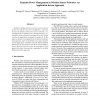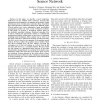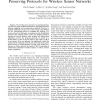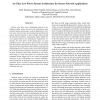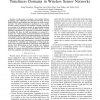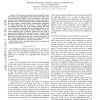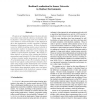WONS
2005
IEEE
14 years 5 months ago
2005
IEEE
Energy is a limited resource in wireless sensor networks. In fact, the reduction of power consumption is crucial to increase the lifetime of low power sensor networks. Several app...
PERCOM
2005
ACM
14 years 5 months ago
2005
ACM
Hybrid sensor networks comprise of mobile and static sensor nodes setup for the purpose of collaboratively performing tasks like sensing a phenomenon or monitoring a region. In th...
LCN
2005
IEEE
14 years 5 months ago
2005
IEEE
— In this paper, we describe a novel localization method for ad hoc wireless sensor networks. Accurate selforganization and localization is an essential characteristic of high pe...
ISDA
2005
IEEE
14 years 5 months ago
2005
IEEE
Due to the wide deployment of sensor networks recently security in sensor networks has become a hot research topic. Popular ways to secure a sensor network are by including crypto...
ISCAS
2005
IEEE
14 years 5 months ago
2005
IEEE
Abstract— The wireless sensor network is an emerging technology that may greatly facilitate human life by providing ubiquitous sensing, computing, and communication capability. H...
ISCA
2005
IEEE
14 years 5 months ago
2005
IEEE
Recent years have seen a burgeoning interest in embedded wireless sensor networks with applications ranging from habitat monitoring to medical applications. Wireless sensor networ...
INFOCOM
2005
IEEE
14 years 5 months ago
2005
IEEE
— In this paper, we present a novel packet delivery mechanism called Multi-path and Multi-Speed Routing Protocol (MMSPEED) for probabilistic QoS guarantee in wireless sensor netw...
INFOCOM
2005
IEEE
14 years 5 months ago
2005
IEEE
— Wireless sensor networks offer the potential to span and monitor large geographical areas inexpensively. Sensor network databases like TinyDB [1] are the dominant architectures...
ICRA
2005
IEEE
14 years 5 months ago
2005
IEEE
Abstract— Multiple-target tracking is a canonical application of sensor networks as it exhibits different aspects of sensor networks such as event detection, sensor information f...
ICDCS
2005
IEEE
14 years 5 months ago
2005
IEEE
The process of computing the physical locations of nodes in a wireless sensor network is known as localization. Selflocalization is critical for large-scale sensor networks becaus...
